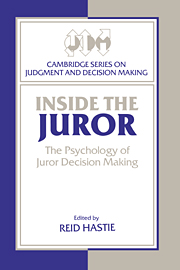Book contents
- Frontmatter
- Contents
- Series preface
- List of contributors
- Editor's preface
- Acknowledgments
- Part I Models of juror decision making
- 1 Introduction
- 2 Some steps between attitudes and verdicts
- 3 The influence of outcome information and attitudes on juror decision making in search and seizure cases
- 4 Algebraic models of juror decision processes
- 5 Stochastic models of juror decision making
- 6 Formal and empirical research on cascaded inference in jurisprudence
- 7 Argument structuring and evidence evaluation
- 8 The story model for juror decision making
- Part II Commentaries
- Index of names
- Index of subjects
4 - Algebraic models of juror decision processes
Published online by Cambridge University Press: 04 August 2010
- Frontmatter
- Contents
- Series preface
- List of contributors
- Editor's preface
- Acknowledgments
- Part I Models of juror decision making
- 1 Introduction
- 2 Some steps between attitudes and verdicts
- 3 The influence of outcome information and attitudes on juror decision making in search and seizure cases
- 4 Algebraic models of juror decision processes
- 5 Stochastic models of juror decision making
- 6 Formal and empirical research on cascaded inference in jurisprudence
- 7 Argument structuring and evidence evaluation
- 8 The story model for juror decision making
- Part II Commentaries
- Index of names
- Index of subjects
Summary
The use of algebraic equations to describe mental processes has been common in psychology since the field became an empirical science. The earliest experimental psychologists utilized algebraic equations to describe the translation of physical stimulation into subjective experience (e.g., Fechner, 1860/1966). Today psychologists use equations to describe many aspects of thought and behavior, ranging from the most peripheral sensory processes of “early vision” to elaborate cognitive processes in problem solving and decision making.
The basic image of the decision maker according to the algebraic modeling approach is a “judgmental accountant” who converts all information relevant to a judgment into numbers representing the implications of each piece of evidence and the importance that should be accorded to each of them and then calculates a weighted sum to provide a “bottom line” evaluation. Benjamin Franklin advised his friends to make decisions using a “prudential algebra” and described it as an accountant tabulating credits and debits to determine the ultimate value of a course of action or choice alternative (in Bigelow, 1887, p. 522). Another image of this process is a physical device that determines the center of gravity of a balance beam from which hang weights (weight represents the implication or “scale value” of an item of evidence) that pull the beam down on the left or right (direction represents guilt or innocence) according to their location on the beam (distance from the fulcrum represents credibility, relevance, or importance of the evidence).
- Type
- Chapter
- Information
- Inside the JurorThe Psychology of Juror Decision Making, pp. 84 - 115Publisher: Cambridge University PressPrint publication year: 1993
- 21
- Cited by

